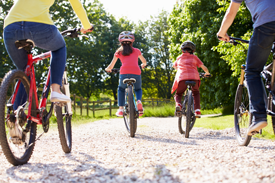Cycling with children
Judging traffic is a practical skill that needs to be learnt. With time, patience and your help your child will acquire skills under your supervision, giving them confidence and experience.
Start from the earliest possible age, and teach them how to cycle safely. The early they start the quicker their confidence will grow.
Before starting out
Are they riding the correct size bicycle?
- Your child should be able to touch the ground with the balls of their feet.
- They should be able to reach the handlebars comfortably so they can apply the brakes easily.
- Do not buy a buy a big bike that you child will grow into, or one which is too heavy as you can put them off cycling.
Is bike is road worthy?
- Brakes - check both to ensure they are in full working order.
- Tyres - check for wear and ensure they are properly inflated.
- Chain - keep oiled, to work freely and free from rust.
- Steering - check the handlebars are in line with front wheel and are not loose.
- Saddle – make sure it is the correct height, your child should be able to place both the balls of their feet on the ground.
Why wear a helmet?
- Wearing a cycle helmet is the best way to protect the head.
- Make sure it is the correct size and is fitted properly; this can substantially reduce the risk of brain injury in the event of a fall.
- Don’t forget you are a role model for your child, so please wear too.
Getting noticed
- Wear reflective clothing or accessories or wear something white / bright. This will make it easier for other road users to see them and you.
- Lights and reflectors. Always use front and rear lights and reflectors after sunset and before sun rise. They also help you be seen when it is foggy or there is poor or reduced visibility.
Good bike control
- Make sure your child can:
- Start and stop without wobbling
- Cycle in a straight line
- Turn to both right and left
- Use both brakes to stop smoothly.
Plan your Journey
- Talk with your child about your potential journey:
- Junctions you will need to negotiate.
- Who has the right of way.
- About roads with no road markings as it may make it unclear who has right of way.
- Are there any hazards when passing parked vehicles? E.g. vehicle doors opening: if possible pass with 1 meter distance between you and the vehicle.
- Discuss the risk of passing driveways e.g. vehicles may be reversing.
- Talk with your child about how they can make their journey safer by looking for traffic and signalling.
On your journey
Road position
- Cycle approximately 60cm from the kerb to avoid drain and debris.
- It is advisable to have your child in front of you, slightly to the left. This will give drivers the opportunity to see you first and will allow you to give instruction and watch your child.
Ask questions
- Reaffirm your child’s understanding during your journey by asking questions on:
- Signalling
- Stopping.
Be a role model follow the rules of the road
- Look before starting, stopping turning left or right, and also changing position in the road.
- Give clear hand signals when necessary, to inform other road users where you are going.
- If the roads become too busy, do not feel you have to continue cycling; you can always get off and walk.
- Respect traffic signs and signals.
By cycling with your child you will also give them the opportunity to gain experience of being in traffic, contributing to them becoming a safer cyclist.
Only allow your child to make a journey alone when you are sure they have the decision making skills to cope with any situation.
Cycle training at school
Once your child is over the age of nine they may be able to take part in a Cycle Training course at their primary school.
